Comparing Efficiencies of Two Selection Approaches for Improving Fusarium Basal Rot Resistance in Short-Day Onion after a Single Cycle of Selection
Abstract
1. Introduction
2. Materials and Methods
2.1. Plant Materials
2.2. Design of the Experiment
2.3. Screening of FBR-Resistant MB Populations Via Field Inoculation
2.4. Selection of FBR-Resistant S Populations Via Growth Chamber Inoculation
2.5. Seed Production of the MBS Cultivar Populations
2.6. Seed Production of the SS Cultivar Populations
2.7. Field Inoculation Evaluation of the Original, MBS, and SS Populations
2.8. Seedling Inoculation Evaluation of the Original, MBS, and SS Populations
2.9. Data Collection and Statistical Analysis
3. Results
3.1. Field Inoculation Evaluation of the Original, MBS, and SS Populations
3.2. Seedling Inoculation Evaluation of the Original, MBS, and SS Populations
4. Discussion
5. Conclusions and Recommendations
Author Contributions
Funding
Acknowledgments
Conflicts of Interest
References
- Cramer, C.S. Current and Future Objectives of NMSU’s Onion Breeding Program. In Onion Production and Marketing in New Mexico; Cooperative Extension Service: Las Cruces, NM, USA, 2002; p. 577. [Google Scholar]
- Bacher, J.W.; Pan, S.; Ewart, L. Inheritance of Resistance to Fusarium Oxysporum f. sp. cepae in Cultivated Onions. In Proceedings of the National Onion Research Conference, Boise, ID, USA, 7–8 December 1989; pp. 85–91. [Google Scholar]
- Deacon, J. Fungi as Plant Pathogens. In Fungal Biology; Blackwell Publishing Limited: Malden, MA, USA, 2006; pp. 279–308. [Google Scholar]
- Cramer, C.S. Breeding and Genetics of Fusarium Basal Rot Resistance in Onion. Euphytica 2000, 115, 159–166. [Google Scholar] [CrossRef]
- Havey, M.J. Onion and Other Cultivated Alliums. In Evolution of Crop Plants; Smart, J., Simmonds, N.W., Eds.; Wiley: New York, NY, USA, 1995; pp. 344–350. [Google Scholar]
- Bennett, A.J.; Bending, G.D.; Chandler, D.; Hilton, S.; Mills, P. Meeting the Demand for Crop Production: The Challenge of Yield Decline in Crops Grown in Short Rotations. Biol. Rev. 2012, 87, 52–71. [Google Scholar] [CrossRef] [PubMed]
- Thornton, M.K.; Mohan, S.K. Response of Sweet Spanish Onion Cultivars to Basal Rot and Pink Root. Plant Dis. 1996, 80, 660–663. [Google Scholar] [CrossRef]
- Brown, B.D. Onion Response to Fumigation and P Placement. Onion World 2001, 17, 8–9. [Google Scholar]
- Jawson, M.D.; Franzluebbers, A.J.; Galusha, D.K.; Aiken, R.M. Soil Fumigation within Monoculture and Rotations: Response of Corn and Mycorrhizae. Agron. J. 1993, 85, 1174–1180. [Google Scholar] [CrossRef]
- Özer, N.; Köycü, N.D.; Chilosi, G.; Magro, P. Resistance to Fusarium Basal Rot of Onion in Greenhouse and Field and Associated Expression of Antifungal Compounds. Phytoparasitica 2004, 32, 388–394. [Google Scholar] [CrossRef]
- Esfahani, M.N.; Hosseini, M.; Nasehi, A.; Golkhandan, E. Screening of Onion Seed Sets for Resistance against New Iranian Isolates of Fusarium Oxysporum f.sp. cepa. Arch. Phytopath. Plant Prot. 2013, 46, 1864–1873. [Google Scholar] [CrossRef]
- Galván, G.A.; Koning-Boucoiran, C.F.S.; Koopman, W.J.M.; Burger-Meijer, K.; González, P.H.; Waalwijk, C.; Kik, C.; Scholten, O.E. Genetic Variation among Fusarium Isolates from Onion, and Resistance to Fusarium Basal Rot in Related Allium Species. Eur. J. Plant Pathol. 2008, 121, 499–512. [Google Scholar] [CrossRef]
- Taylor, A.; Vagany, V.; Barbara, D.J.; Thomas, B.; Pink, D.A.C.; Jones, J.E.; Clarkson, J.P. Identification of Differential Resistance to Six Fusarium oxysporum f.sp. cepae Isolates in Commercial Onion Cultivars through the Development of a Rapid Seedling Assay. Plant Pathol. 2013, 62, 103–111. [Google Scholar] [CrossRef]
- Caligiore Gei, P.F.; Valdez, J.G.; Piccolo, R.J.; Galmarini, C.R. Influence of Fusarium Spp.. Isolate and Inoculum Density on Resistance Screening Tests in Onion. Trop. Plant Pathol. 2014, 39, 19–27. [Google Scholar] [CrossRef]
- Rout, E.; Tripathy, P.; Nanda, S.; Nayak, S.; Joshi, R.K. Evaluation of Cultivated and Wild Allium Accessions for Resistance to Fusarium oxysporum f.sp. cepae. Proc. Natl. Acad. Sci. India Sect. B Biol. Sci. 2016, 86, 643–649. [Google Scholar] [CrossRef]
- Lopez, J.A.; Cramer, C.S. Screening Short-Day Onion Varieties for Resistance to Fusarium Basal Rot. Acta Hortic. 2004, 637, 169–173. [Google Scholar] [CrossRef]
- Goldman, I.L. A List of Germplasm Releases from the University of Wisconsin Table Beetbreeding Program, 1964–1992. HortScience 1996, 31, 878–879. [Google Scholar] [CrossRef]
- Retig, N.; Kust, A.F.; Gabelman, W.H. Greenhouse and Field Tests for Determining the Resistance of Onion Lines to Fusarium Basal Rot. J. Am. Soc. Hort. Sci. 1970, 95, 422–424. [Google Scholar]
- Somkuwar, R.G.; Veere Gowda, R.; Singh, T.H.; Pathak, C.S. Screening of Onion for Resistance to Onion Basal Rot. Madras Agric. J. 1996, 83, 273–275. [Google Scholar]
- Wang, Q.; Shao, B.; Shaikh, F.I.; Friedt, W.; Gottwald, S. Wheat Resistances to Fusarium Root Rot and Head Blight Are Both Associated with Deoxynivalenol- and Jasmonate-Related Gene Expression. Phytopathology 2018. [Google Scholar] [CrossRef] [PubMed]
- Holz, G.; Davies, P.S. Resistance of Onion Selections to Fusarium oxysporum f.sp. cepae. Phytophylactica 1974, 6, 153–156. [Google Scholar]
- Millett, B.P.; Mollov, D.S.; Iorizzo, M.; Carputo, D.; Bradeen, J.M. Changes in Disease Resistance Phenotypes Associated with Plant Physiological Age Are Not Caused by Variation in R Gene Transcript Abundance. Mol. Plant Microbe Interact. 2009. [CrossRef][Green Version]
- Saxena, A. Screening of Onion Cultivars for Fusarium Basal Rot and Spatial Distribution of Fusarium oxysporum f.sp. cepae. Master’s Thesis, New Mexico State University, Las Cruces, NM, USA, 2007. [Google Scholar]
- Pilotti, C.A. Stem Rots of Oil Palm Caused by Ganoderma Boninense: Pathogen Biology and Epidemiology. Mycopathologia 2005, 159, 129–137. [Google Scholar] [CrossRef]
- Cramer, C.S.; Corgan, J.N. “NuMex Camino” Onion. HortScience 2003, 38, 1251–1252. [Google Scholar] [CrossRef]
- Wall, M.; Corgan, J. “NuMex Sweetpak” Onion. HortScience 1999, 34, 1303–1304. [Google Scholar] [CrossRef]
- Corgan, J.N. ‘NuMex Mesa’ Onion; University of Agricultural Experiment Station: Las Cruces, NM, USA, 1996. [Google Scholar]
- Cramer, C.S.; Corgan, J.N. “Numex Chaco” Onion. HortScience 2001, 38, 1337–1338. [Google Scholar] [CrossRef]
- Corgan, J.N. ‘NuMex Crispy’ Onion; University of Agricultural Experiment Station: Las Cruces, NM, USA, 1996. [Google Scholar]
- Corgan, J.N. ‘NuMex Vado’ and ‘NuMex Luna’ Onion Varieties; University of Agricultural Experiment Station: Las Cruces, NM, USA, 1995. [Google Scholar]
- Lopez, J.A.; Cramer, C.S. Screening Intermediate-Day Onion Lines for Fusarium Basal Rot Resistance. In Proceedings of the National Onion Research Conference, Pasco, WA, USA, 11–14 December 2002; pp. 82–86. [Google Scholar]
- Gutierrez, J.A.; Cramer, C.S. Screening Short-Day Onion Cultivars for Resistance to Fusarium Basal Rot. HortScience 2005, 40, 157–160. [Google Scholar] [CrossRef]
- Corgan, J.N.; Wall, M.M.; Cramer, C.S.; Sammis, T.; Lewis, B.; Schroeder, J. Bulb Onion Culture and Management; New Mexico State University: Las Cruces, NM, USA, 2000; p. 563. [Google Scholar]
- Gutierrez, J.A.; Molina-Bravo, R.; Cramer, C.S. Screening Winter-Sown, Intermediate-Day Onion Cultivars for Resistance to Fusarium Basal Rot. Horttechnology 2006, 16, 177–181. [Google Scholar] [CrossRef]
- Saxena, A.; Cramer, C.S. Screening of Onion Seedlings for Resistance against New Mexico Isolates of Fusarium oxysporum f.sp. cepae. J. Plant Pathol. 2009, 91, 197–200. [Google Scholar] [CrossRef]
- Zhang, J.; Fang, H.; Zhou, H.; Sanogo, S.; Ma, Z. Genetics, Breeding, and Marker-Assisted Selection for Verticillium Wilt Resistance in Cotton. Crop Sci. 2014, 54, 1289–1303. [Google Scholar] [CrossRef]
- Singh, S.P.; Schwartz, H.F. Breeding Common Bean for Resistance to Diseases: A Review. Crop Sci. 2010, 50, 2199–2223. [Google Scholar] [CrossRef]
- Merz, U.; Falloon, R.E. Review: Powdery Scab of Potato-Increased Knowledge of Pathogen Biology and Disease Epidemiology for Effective Disease Management. Potato Res. 2009, 52, 17–37. [Google Scholar] [CrossRef]
- Gordon, T.R.; Martyn, R.D. The Evolutionary Biology Of Fusarium oxysporum. Annu. Rev. Phytopathol. 1997, 35, 111–128. [Google Scholar] [CrossRef]
- Rees, R.W.; Flood, J.; Hasan, Y.; Cooper, R.M. Effects of Inoculum Potential, Shading and Soil Temperature on Root Infection of Oil Palm Seedlings by the Basal Stem Rot Pathogen Ganoderma Boninense. Plant Pathol. 2007. [Google Scholar] [CrossRef]
- Busby, P.E.; Ridout, M.; Newcombe, G. Fungal Endophytes: Modifiers of Plant Disease. Plant Mol. Biol. 2016, 90, 645–655. [Google Scholar] [CrossRef] [PubMed]
- Wissuwa, M.; Mazzola, M.; Picard, C. Novel Approaches in Plant Breeding for Rhizosphere-Related Traits. Plant Soil 2009, 321, 409–430. [Google Scholar] [CrossRef]
- Nel, B.; Steinberg, C.; Labuschagne, N.; Viljoen, A. The Potential of Nonpathogenic Fusarium Oxysporum and Other Biological Control Organisms for Suppressing Fusarium Wilt of Banana. Plant Pathol. 2006, 55, 217–223. [Google Scholar] [CrossRef]
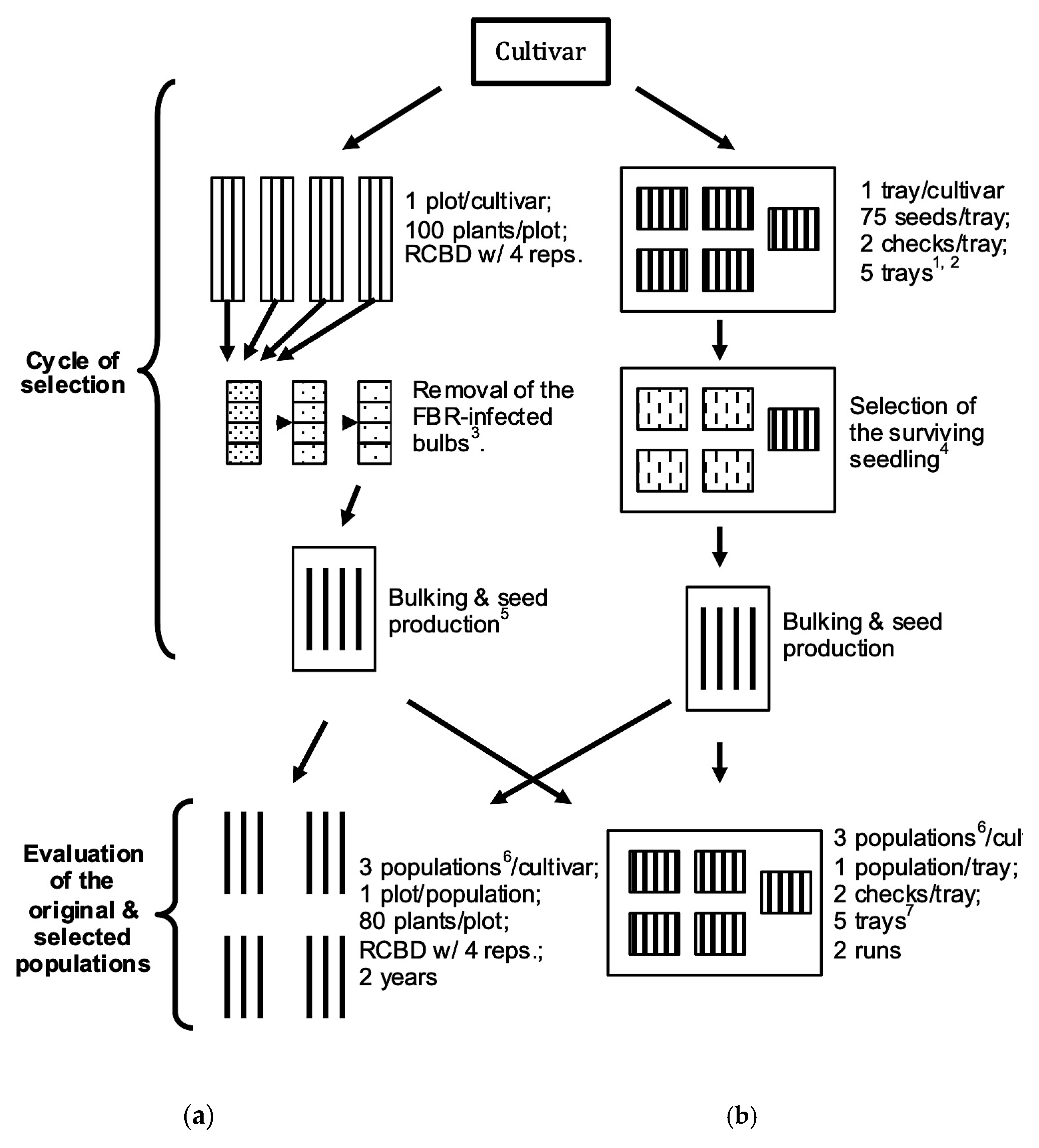


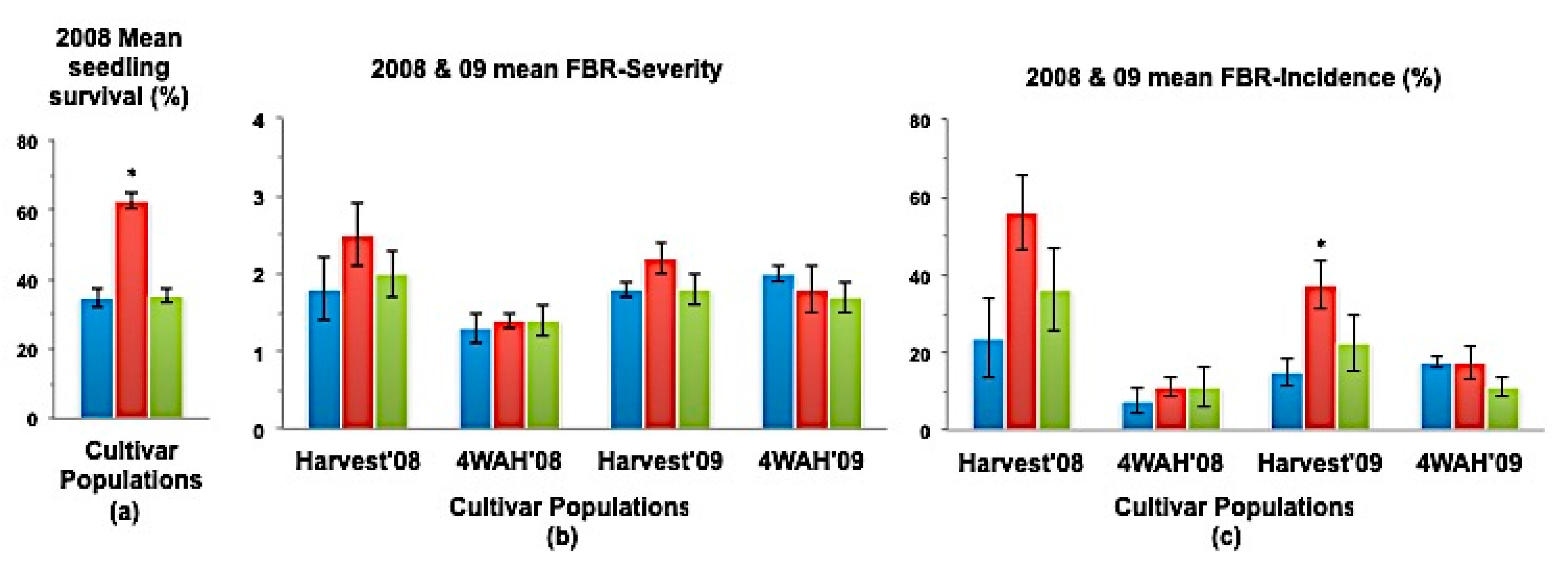

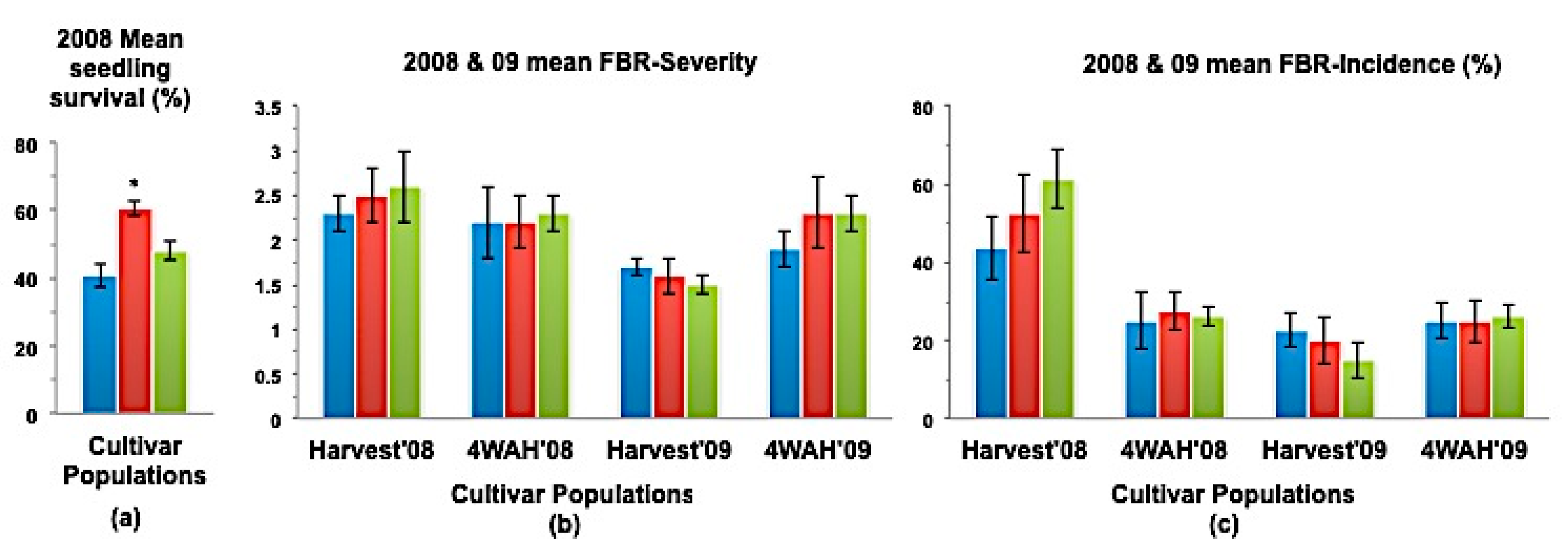
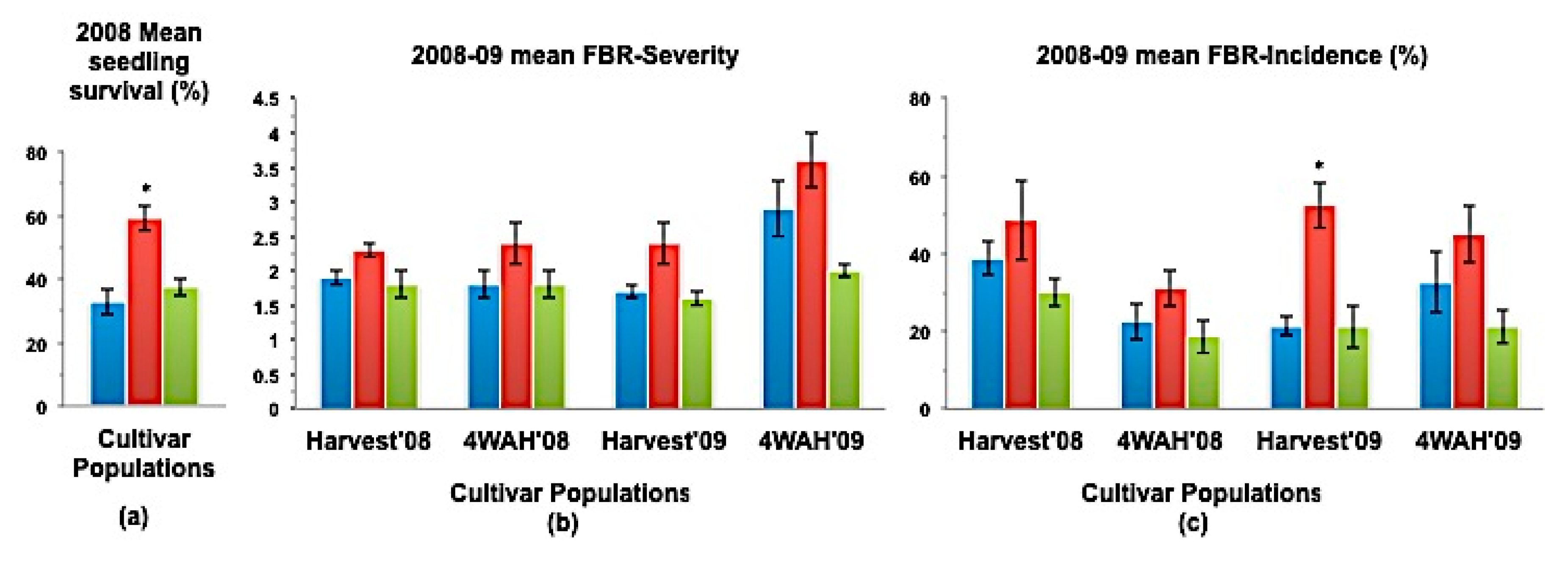
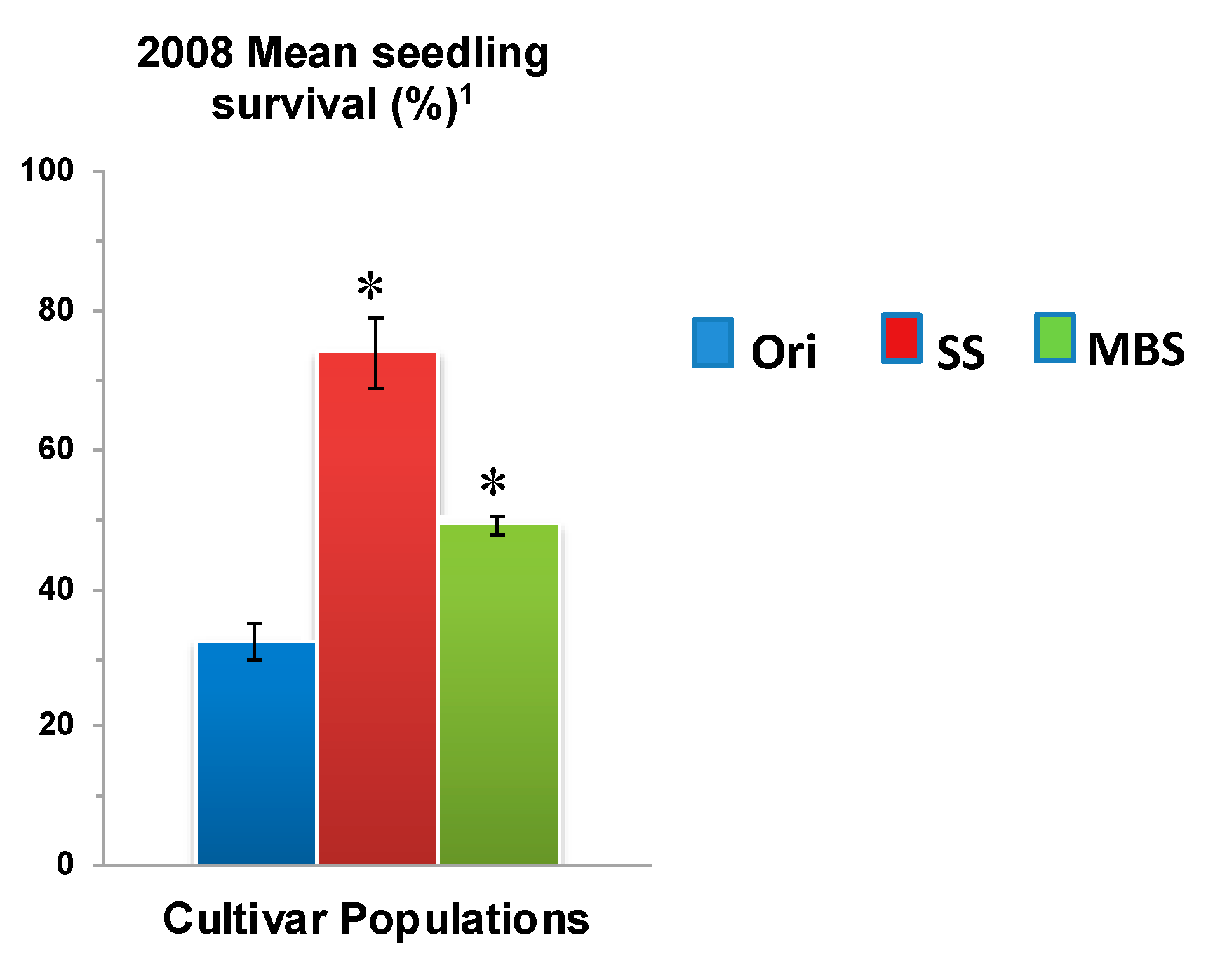
© 2020 by the authors. Licensee MDPI, Basel, Switzerland. This article is an open access article distributed under the terms and conditions of the Creative Commons Attribution (CC BY) license (http://creativecommons.org/licenses/by/4.0/).
Share and Cite
Mandal, S.; Saxena, A.; Cramer, C.S.; Steiner, R.L. Comparing Efficiencies of Two Selection Approaches for Improving Fusarium Basal Rot Resistance in Short-Day Onion after a Single Cycle of Selection. Horticulturae 2020, 6, 26. https://doi.org/10.3390/horticulturae6020026
Mandal S, Saxena A, Cramer CS, Steiner RL. Comparing Efficiencies of Two Selection Approaches for Improving Fusarium Basal Rot Resistance in Short-Day Onion after a Single Cycle of Selection. Horticulturae. 2020; 6(2):26. https://doi.org/10.3390/horticulturae6020026
Chicago/Turabian StyleMandal, Subhankar, Ashish Saxena, Christopher S. Cramer, and Robert L. Steiner. 2020. "Comparing Efficiencies of Two Selection Approaches for Improving Fusarium Basal Rot Resistance in Short-Day Onion after a Single Cycle of Selection" Horticulturae 6, no. 2: 26. https://doi.org/10.3390/horticulturae6020026
APA StyleMandal, S., Saxena, A., Cramer, C. S., & Steiner, R. L. (2020). Comparing Efficiencies of Two Selection Approaches for Improving Fusarium Basal Rot Resistance in Short-Day Onion after a Single Cycle of Selection. Horticulturae, 6(2), 26. https://doi.org/10.3390/horticulturae6020026




